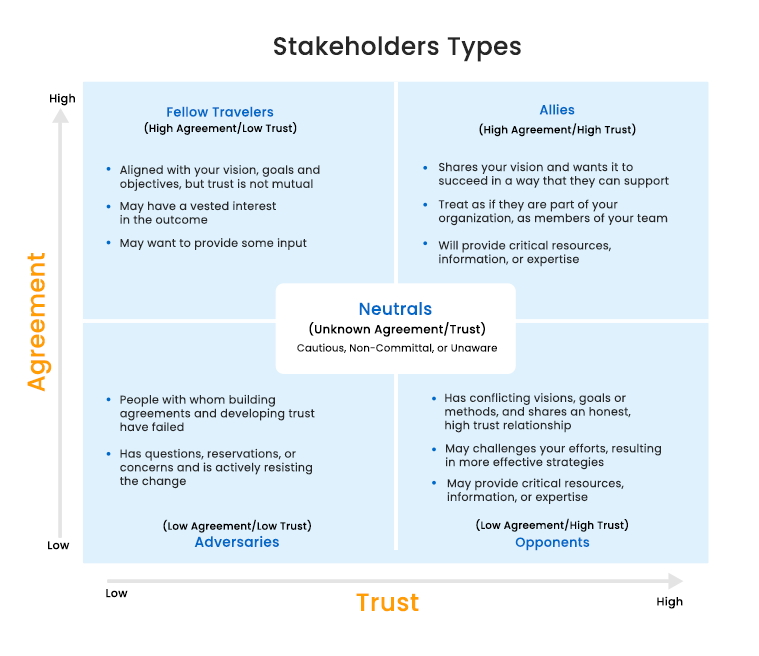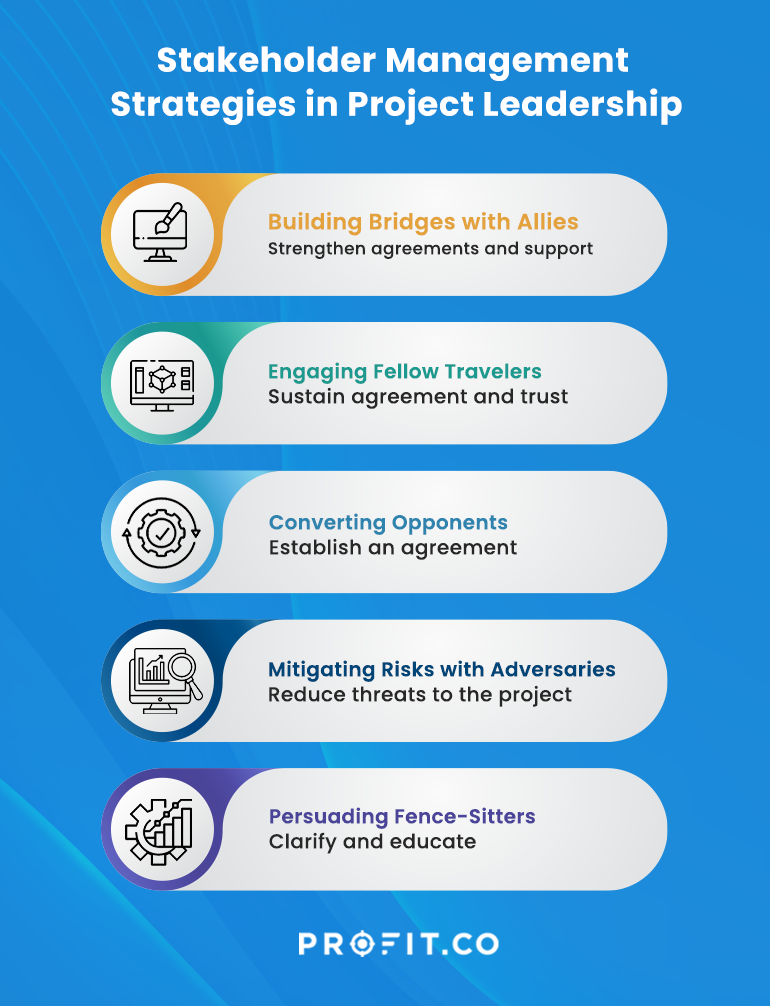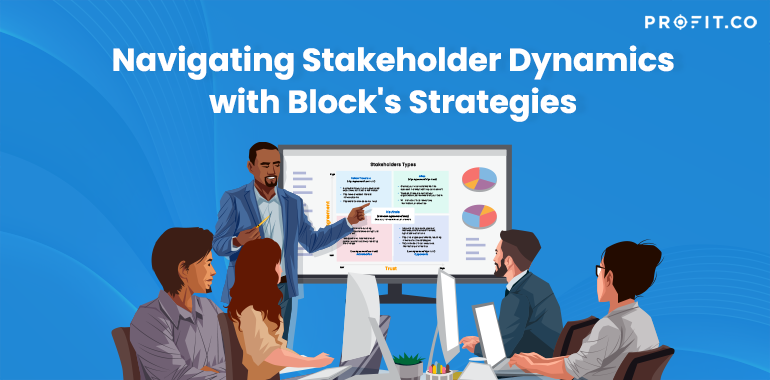Navigating stakeholder relationships effectively is critical in project management. Using Peter Block’s structured approach to stakeholder management, project leaders can ensure robust engagement and sustained support throughout a project’s lifecycle. This guide will explain how to adapt Block’s methodologies across different stakeholder groups, such as Allies, Fellow Travelers, Opponents, Adversaries, and Fence-sitters, to enhance project outcomes.

Building Bridges with Allies
Goal: Strengthen Agreement and Support
Allies are your project’s champions who already share your vision. Deepening these relationships involves:
- Confirming the mutual benefit: Continually validate the value of the partnership and the shared benefits of your project.
- Sharing vulnerabilities: Be open about any uncertainties and seek their counsel, reinforcing their role as trusted advisors.
- Clarifying roles: Define their contributions clearly to maximize their effectiveness and ensure they can advocate for your project confidently.
Example: A project leader might engage department heads early in planning a new software implementation, seeking their insights to address potential technical hurdles proactively.
To boost stakeholder support and project success
Engaging Fellow Travelers
Goal: Sustain Agreement and Trust
Fellow travelers are supportive but not deeply involved:
- Highlighting their role: Regularly communicate the significance of their support and its impact on the project.
- Managing expectations: Clarify that their involvement doesn’t require heavy lifting, which can maintain their support without over commitment.
- Tailoring communication: Discuss and respect their preferred methods and frequencies of updates.
Example: For a community outreach program, periodic updates via email or newsletters can keep less active supporters informed and engaged without requiring their direct involvement.
“When the trust is high, you get the trust dividend. Investors invest in brands people trust. Consumers buy more from companies they trust, they spend more with companies they trust, they recommend companies they trust, and they give companies they trust the benefit of the doubt when things go wrong.”
Converting Opponents
Goal: Establish Agreement
Turning opponents into supporters requires understanding their perspectives and integrating them into the project framework:
- Recognizing their expertise: Identify how their skills can positively impact the project and acknowledge their potential contributions.
- Articulating the vision: Clearly explain the project’s objectives and how they align with the opponent’s interests.
- Collaborative problem-solving: Work together to address specific concerns, which can transform skepticism into partnership.
- Confirming their support: Aim to reach a mutual understanding that leads to their active support.
Example: If facing resistance from the legal department on a new initiative, a project manager might involve them in shaping the compliance aspects, leveraging their expertise to foster alignment and buy-in.
Mitigating Risks with Adversaries
Goal: Reduce Threats to the Project
For those firmly against the project, strategies focus on minimizing their negative impact:
- Evaluating their influence: Understand how their opposition could realistically impact the project.
- Learning from others: Consult colleagues who know the adversary well to better understand their reservations.
- Engaging respectfully: Use discussions to respectfully uncover the root causes of their resistance and address these points directly.
- Ending on a forward-looking note: Conclude interactions with a clear outline of next steps, avoiding ultimatums or demands.
Example: In a merger scenario, identifying and addressing the core concerns of a key skeptic can mitigate potential disruptions.
Persuading Fence-Sitters
Goal: Clarify and Educate
Fence-sitters require information and reassurance before they choose a side:
- Presenting clear benefits: Describe how the change will benefit them directly.
- Seeking their position: Directly ask for their current stance and what concerns they might have.
- Extending invitations: Offer opportunities for them to become more involved, showing that their participation is valued and crucial.
Example: Introducing a new workplace policy might involve hosting informal lunch-and-learn sessions where undecided employees can voice concerns and learn more about the policy’s benefits.

Do not lose focus. Keep the end goal in mind always.
Effective stakeholder management is a delicate art, blending tactful engagement with strategic communication. As Peter Drucker once insightfully noted, “The most important thing in communication is hearing what isn’t said.” This wisdom underscores the importance of not just the messages we deliver but also the underlying concerns and motivations of those we engage with. By applying Peter Block’s nuanced approaches to various stakeholder types, project leaders are equipped to navigate these complex interpersonal landscapes effectively.
Block’s methodology recognizes the diverse landscape of stakeholder interests and the importance of tailored communication strategies. Each category of stakeholder—from Allies to Adversaries—demands a unique approach, reflecting their relationship to the project and potential impact on its outcomes. For instance, with Allies, it’s about deepening trust and reaffirming commitments. As Block himself suggests, “Transformation comes more from pursuing profound questions than seeking practical answers.” It is this pursuit of understanding and connection that solidifies alliances.
With more challenging groups like Opponents and Adversaries, the strategies shift towards building bridges and mitigating risks. Here, the words of Sun Tzu resonate: “The supreme art of war is to subdue the enemy without fighting.” In the context of stakeholder management, it translates to addressing conflicts and resistance through dialogue and inclusion rather than confrontation.
The ability to effectively manage these relationships can significantly dictate the trajectory of a project. As Block advises, engaging stakeholders is not just about managing as usual but about fostering an environment where every voice can contribute to a shared vision. This approach doesn’t just manage stakeholders; it transforms them into active participants and champions of change.
By weaving together these strategies, project leaders can steer their initiatives toward not just completion but success. The complexity of human relationships requires that leaders be as skilled in communication as they are in strategic planning, making Block’s stakeholder management strategies invaluable tools in the arsenal of any effective leader.
To learn how to streamline your projects
Related Articles
-
Profit.co is FedRAMP Ready. Trusted Execution for Federal Agencies Just Got Simpler
In a world where data security, compliance, and mission success are non-negotiable, Profit.co stands out as a trusted partner for... Read more
-
Tim Newbold: Drive OKR Outcomes with Confidence Scoring
You're not alone if you're unsure how confident your team is about achieving its OKRs this quarter. Many teams operate... Read more
-
Tim Newbold on Leading Outcome-Obsessed Teams with OKRs
In many team meetings, a recurring pattern emerges Team members provide updates such as, “I completed tickets 247 and 248,”... Read more
-
How Top Teams Win with Weekly OKR Check-Ins – Insights from Tim Newbold
Set a goal. Cross your fingers. Hope for the best.Sounds familiar?That’s how too many teams treat OKRs. They set goals,... Read more


